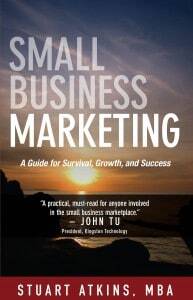ROI rather than just cost should determine your marketing budget. If you don’t spend money you won’t make money. As a consultant, I sometimes hear the words, ” I only have a tiny budget.” “I can’t afford advertising.” “I can’t afford your fees.” “I don’t have any money for marketing.” However, you get what you pay for, especially with your marketing budget. Sure, good marketing costs money, but little or no marketing may cost you your business. In this economy, marketing expenses must be justified so money is not thrown to the wind. So let’s talk ROI and why we need to think ROI first and cost second.

ROI means “Return On Investment.” It’s the return you get from a marketing investment divided by the marketing investment costs. It’s the profit generated by marketing activities. Just like any investment instrument such as the stock market, you invest money to equal and then surpass your out-of-pocket expense. You spend $1000 to get $1200 back over X time period for a 20% return on that investment. You initially spent money but profit was the end result, thus making your money work for your business so you can grow from the profits. A loss kills growth. If it’s a good investment and you don’t spend anything, sure, you keep your $1000 safe and sound, however you run the risk of throwing that $200 return out the window. Gone for good. Your competition that does spend money gets the $200 profit, plus they may retain your lost customer for their future sales. Your competition makes an investment and creates both profit and a customer. This customer may come back to them for more. You spent nothing and got nothing. No customer. No profit.
I decided to self-publish my book. I could have gone with a traditional publisher but I wanted the freedom a quality, indie publisher provided, like Createspace wtih Amazon. It took six months of sales to recoup the initial expenses. I also invest in a Google Adwords advertising campaign. The past three years have been almost pure profit. That’s Return On Investment. ROI personified. It works. I took the risk and the reward has gone beyond profits. ROI on steroids.

I don’t mean to insult anyone’s intelligence. However, we often think “risk of expense” instead of the “reward from return.” We spend money to make money. No spend, no profit. So ask yourself, “What’s my average profit per product or transaction?” If I make that $200 for every customer or client that walks through the door and I spend $1000 on advertising, how many paying customers will it take to recoup that $1000?”: Five.
One more example. The average ROI for every $1 spent on traditional direct mail is $7. The average ROI for every $1 dollar spent on internet marketing is roughly $22 dollars. And, the average ROI for every $1 dollar spent on e-mail marketing is roughly $43 dollars. E-mail marketing wins hands down, yet all include a positive ROI. Use a balance of all three but know which performs best given your target customer market.
Granted, some investments take time and may not always create immediate return. Be patient. These investments may even create some initial losses but at least you’re taking the risk–the key to verb-oriented marketing. Not a gamble but a wise risk. It’s seeking return not recklessness. You’re learning what works and what doesn’t. A parked car will get you nowhere–it has to move. Do something. Your competition will not sit still.
Sometimes I have to say no to potential clients. It’s just not worth the return on my biggest investment: time. When a potential client says to me, “Your consulting fees are too expensive,” I simply say, “The problem your business faces is far more expensive than my fees.”
Get some return–it’s worth the investment.
Stuart Atkins


Leave a Reply